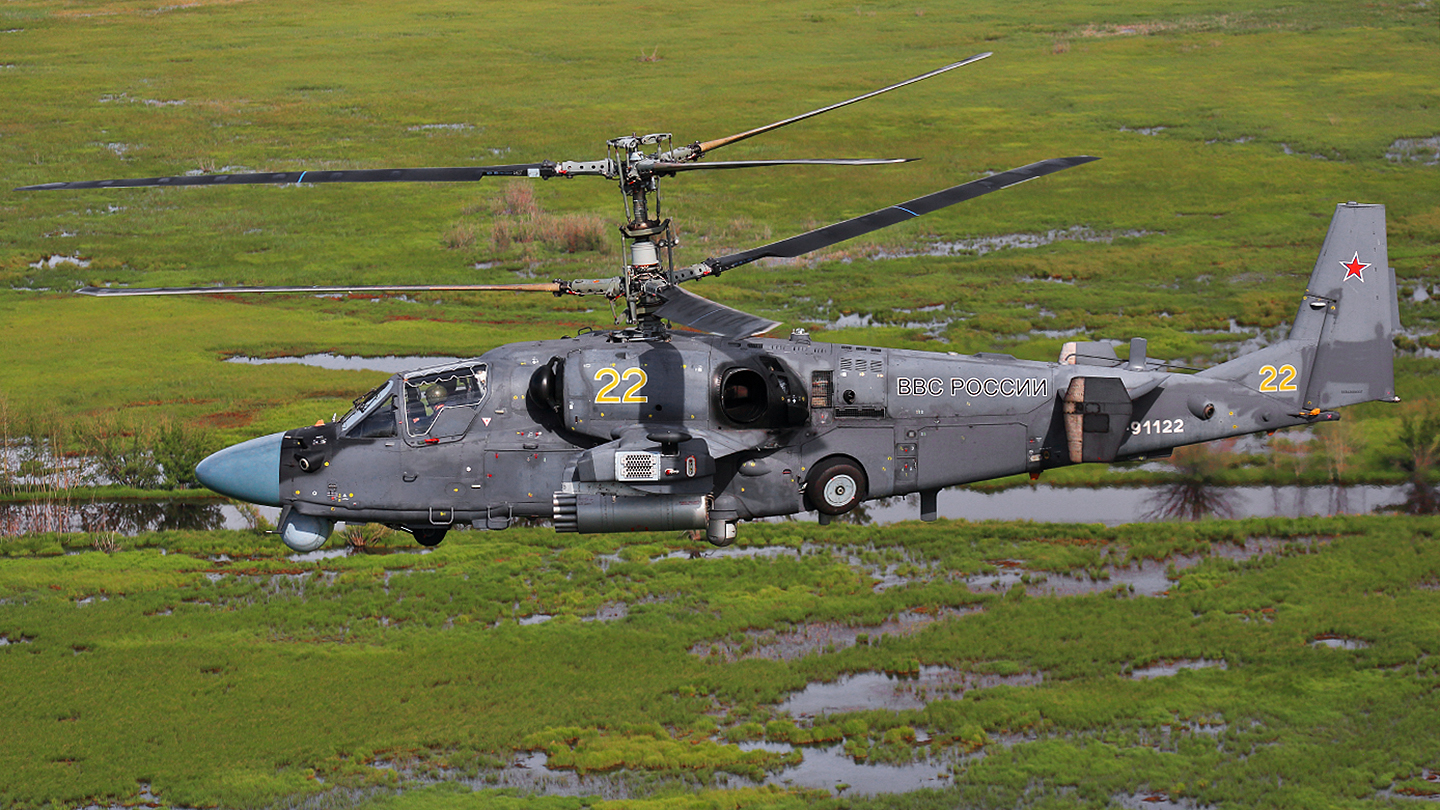The first photos of a new version of the modernized Ka-52M combat helicopter have appeared in Russian service, with the strong possibility that it’s already participating in the full-scale invasion of Ukraine. While the basic Ka-52 Hokum has become a signature weapon of the Russian campaign, sustaining both heavy losses and inflicting a steady toll on Ukrainian armor, this iteration of the improved Ka-52M version had not been seen anywhere until last week.
The Ka-52M in question appeared in three photos posted on the usually well-informed Fighterbomber channel on Telegram. Among others, this channel conducts fundraising and gives Russian airmen involved in the Ukrainian war flight suits, shoes, radios, navigation devices, first aid kits, etc. In pictures posted on July 14, airmen present some of the gadgets they received against the backdrop of the new version of the Ka-52.

The helicopter seen in the Fighterbomber photos has fresh paintwork, indicating that it was recently delivered. Photos of this kind, on this channel, have previously generally been taken at deployed locations in Ukraine, or at airbases in Russia that are used to support the campaign there. While we can’t be sure that these photos originate in Ukraine, or at a Russian airbase used in the conflict, the connection with the Fighterbomber effort to source equipment for aircrews suggests that it’s at least likely.
Media reports of the use of the Ka-52M in Ukraine had already appeared, but they were not supported by any imagery. For example, in September 2022, Russia’s state-owned TASS news agency described “successful tests of this modernized helicopter during the special operation in Ukraine.” In Russia, the invasion of Ukraine is still known as a “special military operation.”
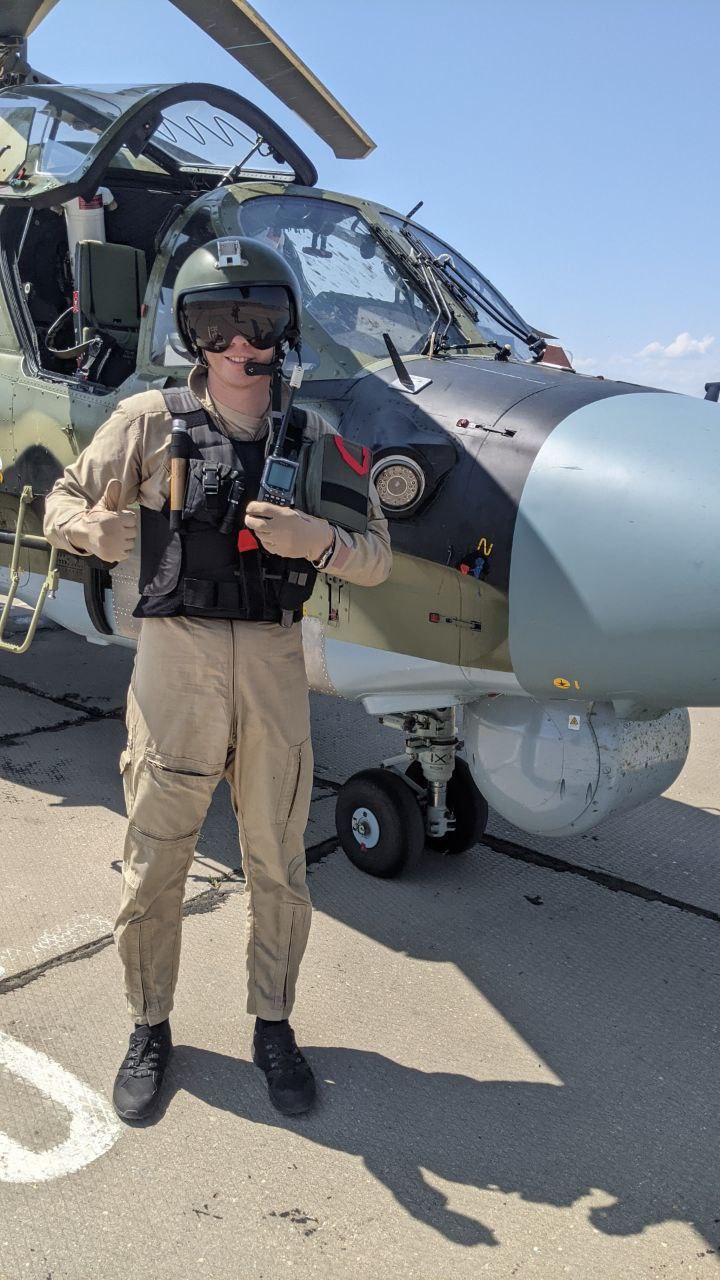

What is the Ka-52M?
On April 5, 2019, the Kamov company received a contract from the Russian Ministry of Defense for the Avangard-4 research and development work, the aim of which was to develop a modernized Ka-52M (the Mi-28NM helicopter being developed at the same time is codenamed Avangard-3). Actual work had started much earlier than the contract and the new equipment and armament used in the Ka-52M were almost ready by this time.
In June 2020, the Progress plant at Arsenyev in Russia’s Far East, which produces Ka-52s, received an order to convert two helicopters into Ka-52M versions for trials. The first Ka-52M made its first post-conversion flight on August 10, 2020. According to the contract, the Ka-52M was to have completed all its tests and be ready for series production by the end of September 2022.
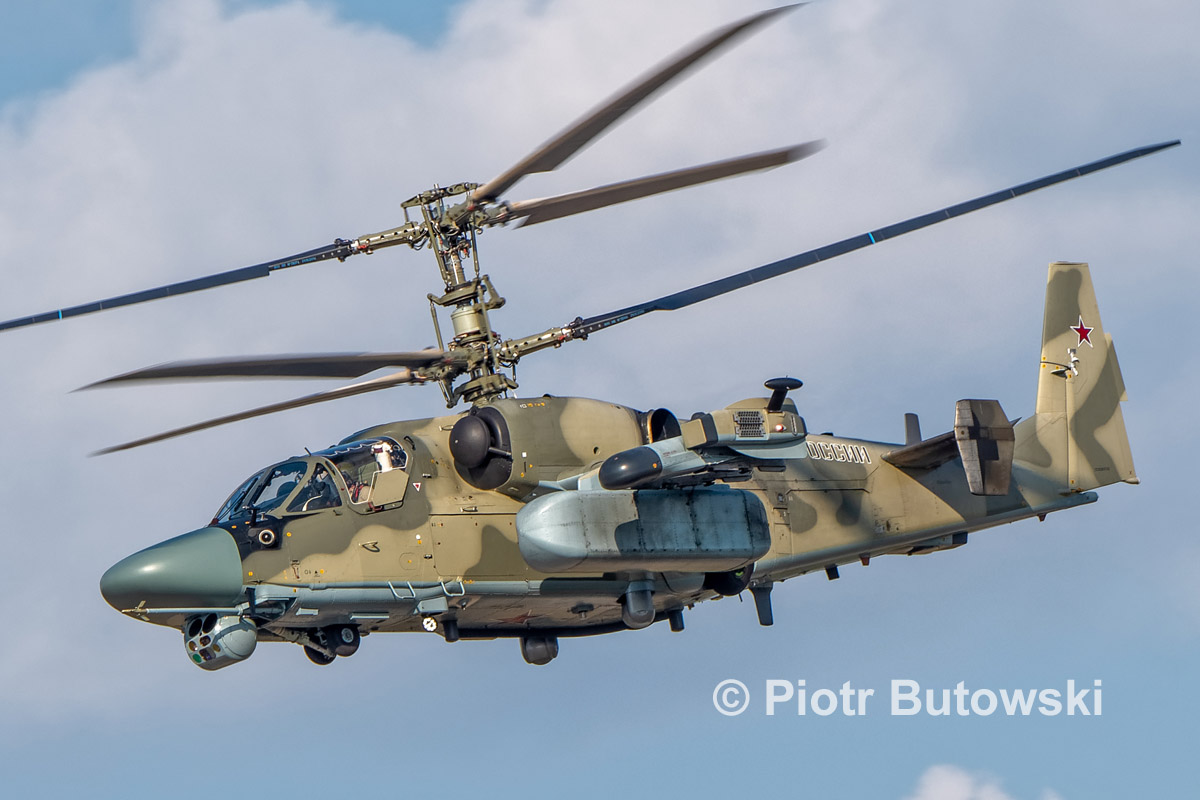
The first Ka-52M was shown to the public during Russia’s International Aviation and Space Show (MAKS) in July 2021, and then at the Army-2021 exhibition the following August. The helicopter received a modernized GOES-451M electro-optical targeting turret, the updated BKS-50M (Bortovoi Kompleks Svyazi) communication suite, as well as the SUO-806PM (Sistema Upravleniya Oruzhiyem) stores management system, capable of employing new weapons. The most significant addition to the helicopter’s armament is the introduction of the LMUR guided missile with a range of up to nine miles. You can read a full description of this important weapon in this previous article.


Other upgrades were introduced to the helicopter itself. The Ka-52M’s rotor blades have a more powerful heating element, which allows the helicopter to operate in a wider temperature range, including in the Arctic, a particular focus of recent Russian military strategy. The landing gear features wheels with increased load capacity and wear resistance and the helicopter also has external LED lighting. The crew cockpit has improved ergonomics and is also better adapted to flying with night vision goggles (NVGs).
In terms of specifications, the Ka-52M (known within the factory as the izdeliye 800.50) has a maximum takeoff weight of around 27,000 pounds, a maximum speed of 186 miles per hour, a ceiling of 18,045 feet, and a range of 286 miles.
Production steps up
The contract for the first batch of 30 Ka-52Ms for the Russian Aerospace Forces was signed on August 24, 2021, during the Army-2021 forum; 15 helicopters were to be delivered in 2022 and 15 in 2023. It’s likely this contract has already been fulfilled. During the next Army-2022 forum, the Russian Ministry of Defense placed another order for an unknown number of Ka-52Ms. In July 2023, the Russian Minister of Defense Sergei Shoigu said that deliveries of the Ka-52 in 2023 “have doubled” compared to 2022, i.e. amounting to approximately 30 helicopters, if true.
After around 18 months of fighting, Russia has lost almost 40 Ka-52 combat helicopters in Ukraine out of approximately 140 it had at the beginning of the war (in terms of all types of attack helicopters, Russia has lost around 70 out of over 400 at the beginning of the war). In addition to the Ka-52, there are two other types of combat helicopters in production in Russia, the Mi-28N/NM and the Mi-35M, both produced at the Rostvertol plant in Rostov-on-Don. Together with the information about the doubling of the production of the Ka-52, Shoigu said that the production of the Mi-28 had been increased by a factor of three in 2023 compared to 2022 (i.e. to approximately 50 per year).
New GOES-451M targeting payload
Returning to the new photos of the Ka-52M, arrow number one points to the GOES-451M electro-optical payload installed under the front of the fuselage; the standard version of the helicopter has a GOES-451 turret in this position. The turret houses a thermal imaging camera, TV camera, laser rangefinder/designator, laser beam riding output for anti-tank missiles, as well as laser spot tracker.
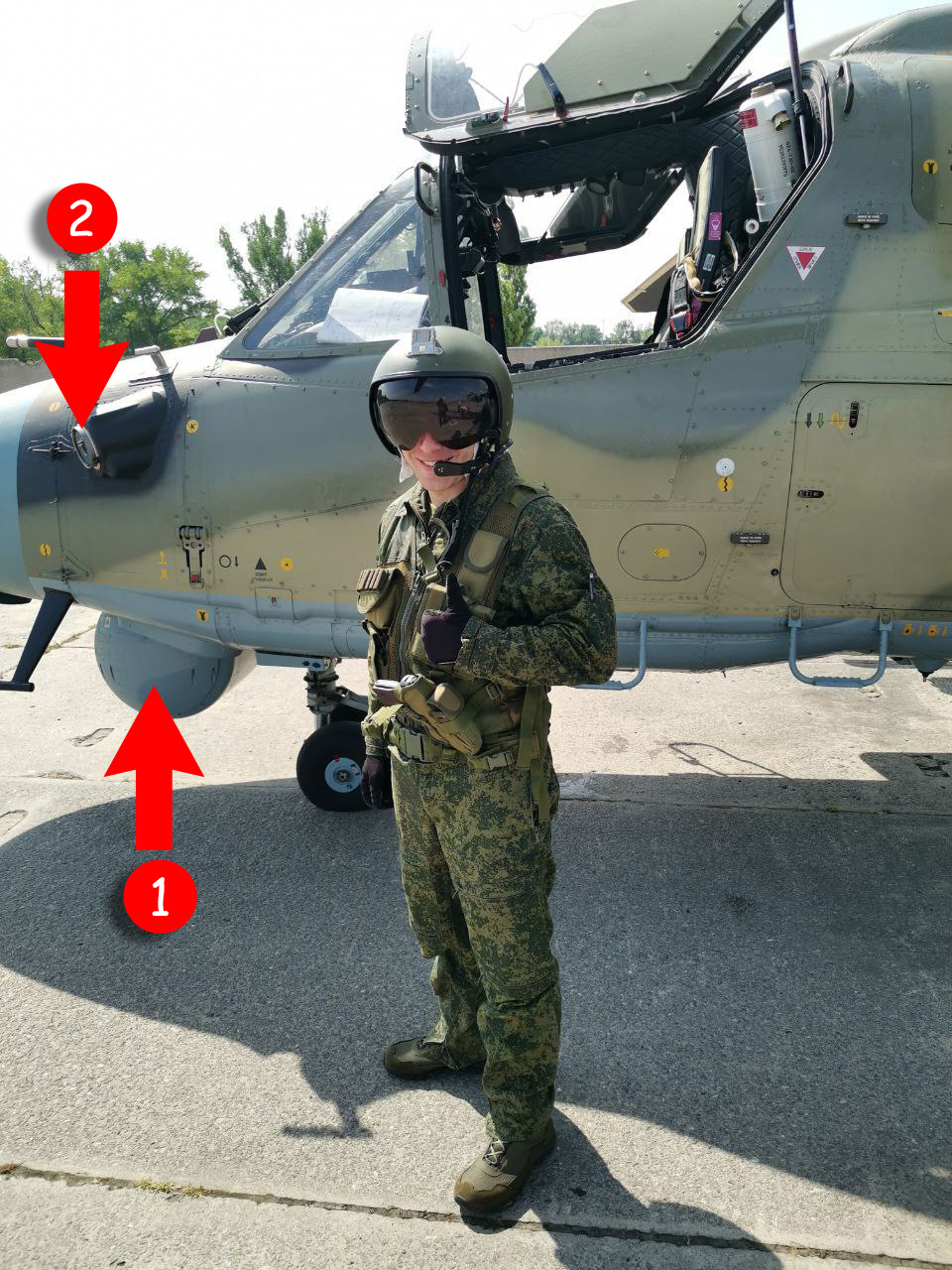

The GOES-451M payload’s sensors offer an increased detection and recognition range to match the ranges of new types of weapons, including the LMUR missile. The payload’s manufacturer, UOMZ of Yekaterinburg, declares a tank detection range of 9.3 miles using the TV channel and 7.5 miles with the thermal imaging channel; target recognition ranges are 7.5 miles and 5 miles, respectively.
New L418 Monobloc self-defense suite
Arrow number two points to the L418-2 ultraviolet missile approach warning sensor (MAWS) produced by the GIPO company in Kazan, part of the L418 Monobloc self-defense suite. Regular Ka-52s, as well as previously seen Ka-52M prototypes, have the L370P2 Vitebsk suite with the L370-2 MAWS in this position. Four such sensors are positioned on the sides of the forward fuselage and the tail boom, covering a full 360 degrees around the helicopter.

The L418 Monobloc is made by NII Ekran in Samara. This is a modernization of the L370 Vitebsk system, which works across a broader band of frequencies and at longer ranges.

While the new photos don’t show it, the Ka-52M helicopter most likely also has other new components of the L418 suite, primarily two L418-5 directional infrared countermeasures (DIRCM) fairings made by SKB Zenith in Zelenograd, installed on the sides of the lower part of the fuselage, just ahead of the main landing gear. The new L418-5 jammer is angular in shape, while the previous L370-5 was a rotating sphere (nicknamed ‘eggs of life’); inside, there is a new SP3-1500 (previously, SP2-1500) lamp that generates modulated infrared and ultraviolet radiation to jam the infrared seekers of air-to-air and surface-to-air missiles.

Interestingly, the L418 Monobloc sensors were installed on Ka-52E helicopters sold to Egypt well before they appeared on Russian helicopters. This was a result of the Russian Ministry of Defense’s more stringent formal requirements for the equipment, and perhaps also due to additional functions required by the Russian military. The introduction of new equipment of this kind in Russia requires multi-stage tests that are not necessarily needed by a foreign customer. In a similar way, Mi-28NE helicopters delivered to Iraq received radars in February 2015, while deliveries of helicopters with radars to the Russian Aerospace Forces started only at the end of 2017.
Now, in wartime conditions, Russia has significantly reduced such requirements and are throwing into the fight equipment that is apparently still far from mature. Perhaps the best example of this is the UMPK wing kit/guidance module installed on general-purpose bombs, something that The War Zone has also explored in detail.
New radar
Most interesting is an apparently new radar on the Ka-52M seen in the recent photos. Arrow number three points to a small air intake on the underside of the radome in the front of the fuselage; on the other side, symmetrically, is another similar air intake. There are no such inlets in any of the previously seen Ka-52 helicopters.

A single inlet of larger size, but otherwise similar, is seen in the prototype Ka-52K naval combat helicopter numbered ‘103’. And this leads us to a likely conclusion about the purpose of these inlets. In Ka-52K ‘103,’ this inlet is used to cool the antenna of the Rezets active electronically scanned array (AESA) radar, which is undergoing tests on this helicopter.
The Ka-52M prototypes have the same radar as the regular Ka-52, the FH01 Arbalet-52 produced by Phazotron-NIIR of Moscow. It is a Ka-band (8-millimeter wavelength) radar with a wide 31.5-inch mechanical antenna in the nose of the helicopter. The detection range for a large ground target (e.g. a railway bridge) is 15.5 miles, or 7.5 miles for a tank. The weakness of the FH01 radar is the inability to directly target guided missiles. For weapons guidance, target information must be transmitted by the radar to the GOES-451 electro-optical payload, which is the main targeting sensor of the Ka-52.

As to the radar on the new version of the Ka-52M helicopter, this is most likely the V006 Rezets radar from the Zaslon company in Saint Petersburg (the same company that makes the V004 radar used by the Su-34 Fullback fighter-bomber). The V006 or RZ-001 Rezets (cutter) radar has a fixed AESA antenna with 640 transceiver modules. The radar works in the X-band and, according to the manufacturer, can detect a group of tanks from 25 miles and a fighter aircraft from up to 31 miles. The Rezets radar is air-cooled, which is why it needs additional air intakes on the radome.

While the Rezets radar is the most likely option for the Ka-52M, it’s not the only one. Phazotron-NIIR, the manufacturer of the current FH01 radar, also has an offering. The modernized FH02 has two separate antennas: a mechanical slotted array for the Ka- and an AESA for the X-band. This solution allows simultaneous scanning for surface and airspace targets, implementation of advanced target detection and tracking algorithms, and greater reliability. The X-band gives a much greater range, although at the expense of lower resolution. According to the company, a tank can be detected at a distance of 12.4 miles in the Ka range or 21.8 miles in the X range.
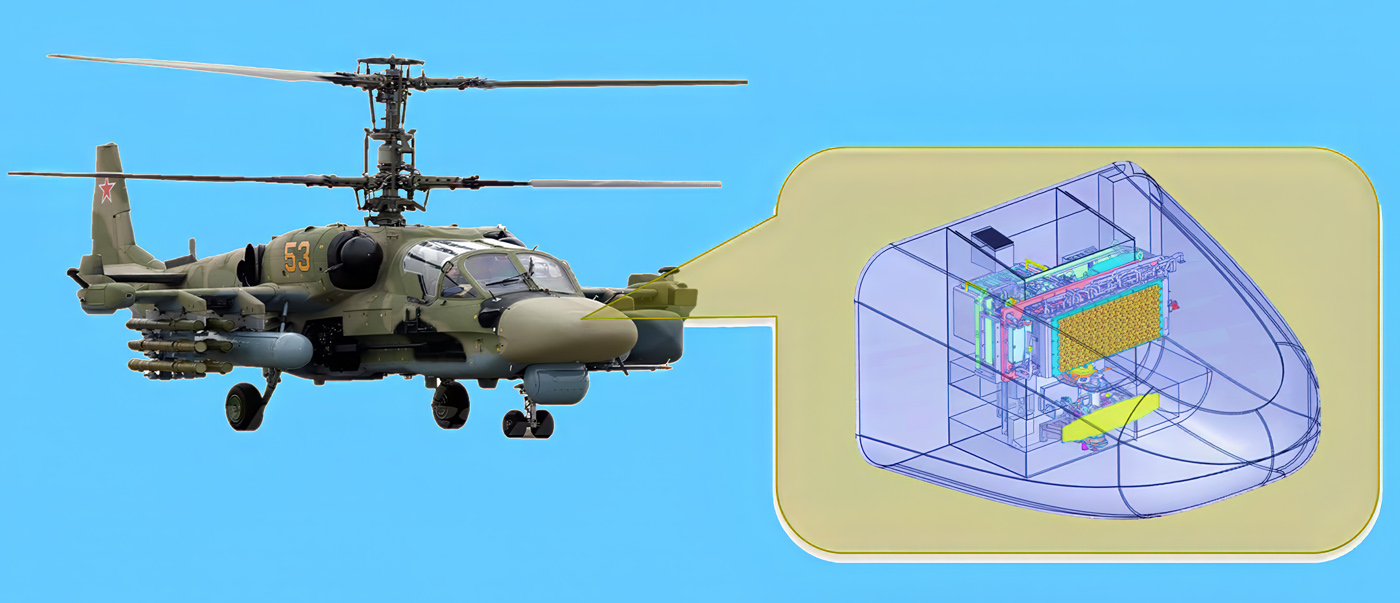
We need to wait for more imagery of the Ka-52M in its new variant to get more clarity about the precise configuration of this new version, and whether it’s already in Ukraine or involved in the war there. At this point, it certainly seems likely. Either way, it’s clear that the helicopter, in general, including in its original Ka-52 variant, will remain a key weapon system for the Russian Aerospace Forces as the Ukrainian campaign grinds on.
Contact the editor: thomas@thedrive.com
